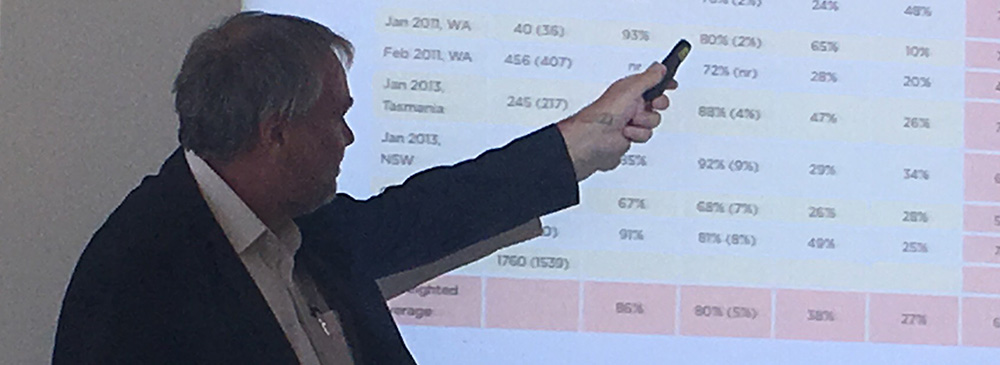By Lauren Price
 Michael Rumsewicz, director of the Bushfire and Natural Hazards Cooperative Research Center in Australia, gives a presentation at the Institute of Behavioral Science at the University of Colorado Boulder on March 23. ©Lauren Price, 2017.
Michael Rumsewicz, director of the Bushfire and Natural Hazards Cooperative Research Center in Australia, gives a presentation at the Institute of Behavioral Science at the University of Colorado Boulder on March 23. ©Lauren Price, 2017.
One of the biggest challenges in disaster research is translating what’s already been learned about disasters into strategies that can alleviate their impacts. Many organizations are addressing this problem, but the Bushfire and Natural Hazards Cooperative Research Center in Australia has developed a particularly innovative approach—one that brings all parties to the table.
The center, which focuses on reducing the economic impacts of hazards and disasters, puts researchers, disaster workers, and emergency service authorities together from the beginning, so they can set goals and collaborate as they plan research and implementation strategies from start to finish.
By implementing this user-guided approach and focusing only on large-scale, national problems, all parties are invested in the outcome of the work—which yields research that will be useful in some form, according to Research Director Michael Rumsewicz, who spoke about the center’s work at the University of Colorado Boulder on March 23.
The center is the result of a national effort by the Australian government to consolidate cooperative research centers in order to achieve a broader goal of a disaster-resilient Australia. Previously, different hazards organizations tended to focus on their own specific hazard, such as wildfires or floods, for example.
By identifying problems and desired outcomes up front, it has become possible for the center to work backwards and unite mitigation efforts among all fields, Rumsewicz said. To accomplish this, the center works with organizations that include fire agencies, universities, wildlife departments, and government offices. One of its main efforts is working with these partners to transition the disaster conversations in communities from risk to consequence.
“Don’t talk about risk,” Rumsewicz said. “It will happen. When people talk about one in 10, one in 100, one in 1000, there’s a one there. It will happen, so let’s deal with making it more resilient.”
While resilience is a popular goal that most agree on, it’s getting communities to invest in mitigation that proves to be a challenge. It’s difficult to convince communities to spend money to prepare for an event that may or may not happen.
One successful tactic used to help break through to people is sharing personal stories, Rumsewicz said. By sharing stories of death and loss, it helps those in the community see themselves in a similar scenario and consider the gravity of what’s faced in a disaster. Flooding, for instance, is a serious threat in some portions of Australia, but frequent enough that people can develop a cavalier attitude towards the danger.
“The types of people floods kill drive into floodwaters; kids playing in the streets,” Rumsewicz said. “We need to get people to tell their stories about how they nearly got swept away.”
It’s understandable that cost plays a key role in decisions about mitigation, but many might not realize that spending that money up front could save them from financial crises after disasters. Investments in flood mitigation are both cost effective and reduce long-term exposure for flood risk, according to Economic Benefits of Flood Mitigation Investments, a 2014 report by URBIS Australia.
As the effects of climate change increase disaster risk, the urgency for addressing ways to alleviate their impact has as well. The most far-reaching risk faced in the coming years is the failure to mitigate and adapt to climate change, according to the 2016 Global Risks Report. The report, published by the World Economic Forum, defines risks as potential conditions that could cause economic, environmental, or societal harm around the globe in the next ten years.
Since mitigation success is a global concern, the work the center does is especially important for enabling quicker policy change and implementation. Rumsewicz said the work they do at the center can serve as an example of how successfully solving mitigation problems can ultimately bring down the cost, and overall loss, that comes with disaster.
Lauren Price is a journalism master's student with a concentration in environment, policy, and society. She works as the student writer for CU Boulder's alumni magazine, the Coloradan, and is volunteering at the Natural Hazards Center during the Spring 2017 semester. She graduated from the University of Delaware in 2014 with a major in English, a concentration in professional writing and triple minors in journalism, Spanish and environmental humanities.